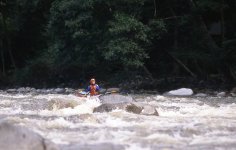No, those were white water boats.
Boat over boat rescues are more difficult with gear but often can be done so long as everything is contained within the hull and the boat and gear are not so heavy that the stem of the boat cannot be lifted up to gunwale height. If one stem of the canoe can be gotten over a gunwale of the rescue boat, the inverted boat and gear have enough buoyancy to act as a very effective outrigger. The inverted boat can the slowly be worked up and over the gunwales of the rescue boat, inverted, and returned to the water. Boat over boat rescues become much more difficult if there is stuff dangling from the boat, tied onto thwarts or anchors at gunwale level.
Boat over boat rescues are obviously much faster and easier if there is no, or only a small amount of gear tied into the boat. And that is one reason that I would not secure buoyant gear in a boat for lake paddling so long as a companion rescue boat is available. A boat over boat rescue of an empty, or near empty boat can be accomplished in seconds, much faster than a swamped boat can be emptied by bailing or with sump pumps, or even multiple electrical sump pumps.
Boat over boat rescues are more difficult with gear but often can be done so long as everything is contained within the hull and the boat and gear are not so heavy that the stem of the boat cannot be lifted up to gunwale height. If one stem of the canoe can be gotten over a gunwale of the rescue boat, the inverted boat and gear have enough buoyancy to act as a very effective outrigger. The inverted boat can the slowly be worked up and over the gunwales of the rescue boat, inverted, and returned to the water. Boat over boat rescues become much more difficult if there is stuff dangling from the boat, tied onto thwarts or anchors at gunwale level.
Boat over boat rescues are obviously much faster and easier if there is no, or only a small amount of gear tied into the boat. And that is one reason that I would not secure buoyant gear in a boat for lake paddling so long as a companion rescue boat is available. A boat over boat rescue of an empty, or near empty boat can be accomplished in seconds, much faster than a swamped boat can be emptied by bailing or with sump pumps, or even multiple electrical sump pumps.

